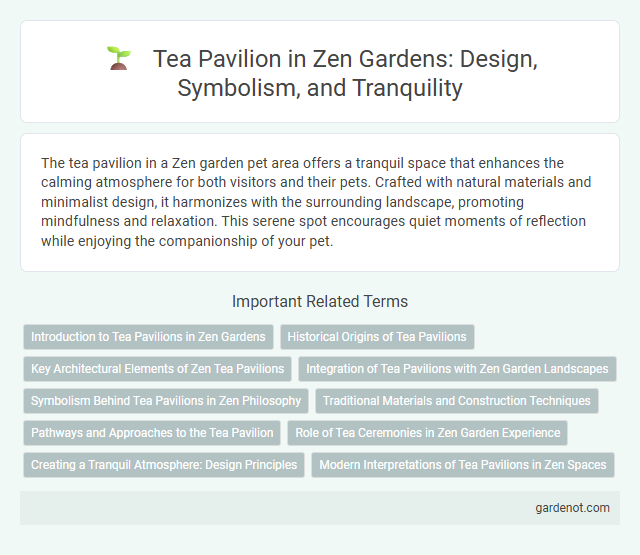The tea pavilion in a Zen garden pet area offers a tranquil space that enhances the calming atmosphere for both visitors and their pets. Crafted with natural materials and minimalist design, it harmonizes with the surrounding landscape, promoting mindfulness and relaxation. This serene spot encourages quiet moments of reflection while enjoying the companionship of your pet.
Introduction to Tea Pavilions in Zen Gardens
Tea pavilions in Zen gardens serve as tranquil spaces designed for the traditional Japanese tea ceremony, emphasizing harmony, mindfulness, and simplicity. These structures are typically crafted using natural materials such as wood and bamboo, blending seamlessly with the surrounding garden's minimalist aesthetic. Positioned strategically within the garden, tea pavilions provide a serene environment that fosters contemplation and appreciation of nature.
Historical Origins of Tea Pavilions
Tea pavilions in Zen gardens originate from traditional Japanese tea ceremonies that date back to the 15th century, specifically influenced by the Muromachi period's cultural aesthetics. These structures embody simplicity and tranquility, designed to harmonize with the surrounding natural elements and facilitate meditation and mindful tea drinking. Their historical significance lies in promoting spiritual reflection and fostering a deep connection between nature, art, and the ritual of tea preparation.
Key Architectural Elements of Zen Tea Pavilions
Zen tea pavilions feature minimalist wooden frameworks with open walls to harmonize indoor and outdoor spaces, emphasizing natural materials like bamboo and stone for a tranquil atmosphere. The roof often has simple, elegant lines with thatched or tiled coverings to blend seamlessly with the garden environment. Sliding shoji screens and tatami mat flooring facilitate fluid movement and maintain traditional Japanese aesthetics essential to the tea ceremony experience.
Integration of Tea Pavilions with Zen Garden Landscapes
Tea pavilions in Zen garden landscapes exemplify harmonious integration by blending traditional architecture with natural elements like bamboo, stone paths, and moss-covered grounds. These structures provide a tranquil space for tea ceremonies, enhancing mindfulness and fostering a deep connection with the surrounding environment. The careful placement of tea pavilions maximizes views of carefully raked gravel, koi ponds, and seasonal flora, embodying Zen principles of simplicity and balance.
Symbolism Behind Tea Pavilions in Zen Philosophy
Tea pavilions in Zen gardens symbolize harmony, simplicity, and mindfulness, reflecting core Zen principles. These structures serve as sacred spaces for meditation and tea ceremonies, embodying the transient beauty of nature and fostering a deep connection between the participant and the present moment. Their minimalist design emphasizes tranquility and spiritual clarity, reinforcing Zen's focus on inner peace and enlightenment.
Traditional Materials and Construction Techniques
The tea pavilion in a Zen garden is meticulously crafted using traditional materials such as natural wood, bamboo, and tatami mats, ensuring harmony with the surrounding environment. Construction techniques emphasize hand-carved joinery and layered thatch roofing, reflecting centuries-old craftsmanship that promotes durability and simplicity. This authentic approach preserves cultural heritage while enhancing the pavilion's tranquil aesthetic and functional design.
Pathways and Approaches to the Tea Pavilion
Pathways to the Tea Pavilion in a Zen garden are carefully designed to encourage mindfulness and tranquility, often featuring stepping stones or gravel paths that invite slow, deliberate movement. Approaches integrate natural elements such as moss, bamboo, and lanterns to harmonize the environment, guiding visitors subtly toward the pavilion. These pathways embody the Zen principle of simplicity, enhancing the spiritual experience before entering the tea ceremony space.
Role of Tea Ceremonies in Zen Garden Experience
The tea pavilion in a Zen garden serves as a serene space designed specifically for traditional tea ceremonies, which embody harmony, respect, purity, and tranquility. These ceremonies enhance the sensory experience by encouraging mindfulness and a deep connection to nature, reflecting Zen principles. By integrating the tea pavilion, Zen gardens foster contemplation and spiritual awakening through the ritualistic preparation and enjoyment of matcha tea.
Creating a Tranquil Atmosphere: Design Principles
The Tea Pavilion in a Zen garden embodies minimalist design principles that emphasize natural materials, clean lines, and harmonious integration with surrounding greenery to foster a serene environment. Its strategic placement near water features or pathways enhances sensory balance, promoting mindfulness and calm during tea ceremonies. Subtle architectural elements like sliding doors and tatami flooring invite quiet reflection, reinforcing the pavilion's role as a peaceful retreat.
Modern Interpretations of Tea Pavilions in Zen Spaces
Modern interpretations of tea pavilions in Zen gardens blend minimalistic design with traditional elements to create serene spaces for mindfulness and tea rituals. Utilizing sustainable materials and clean lines, these structures emphasize harmony with nature while incorporating contemporary architecture and technology. The integration of open layouts and natural light fosters tranquility, enhancing the meditative experience within Zen environments.
Tea pavilion Infographic

 gardenot.com
gardenot.com